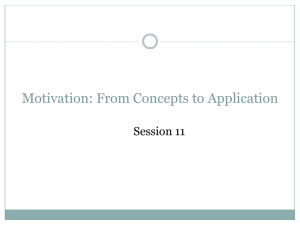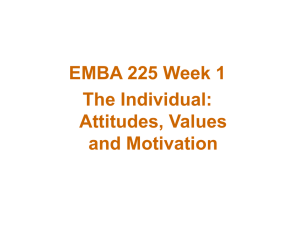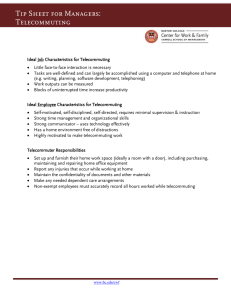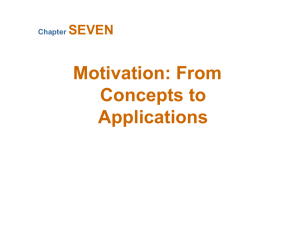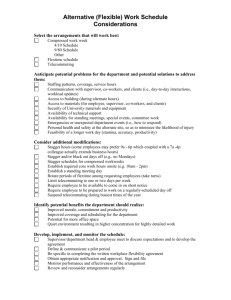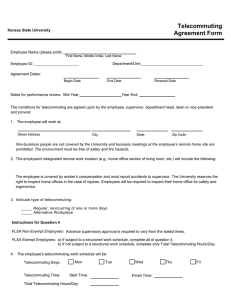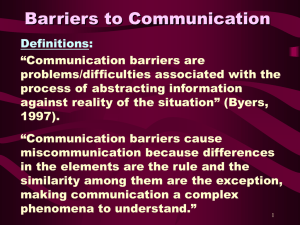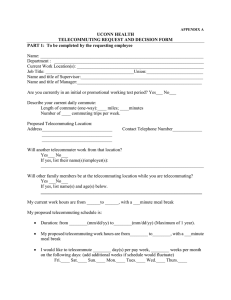Motivation in applications
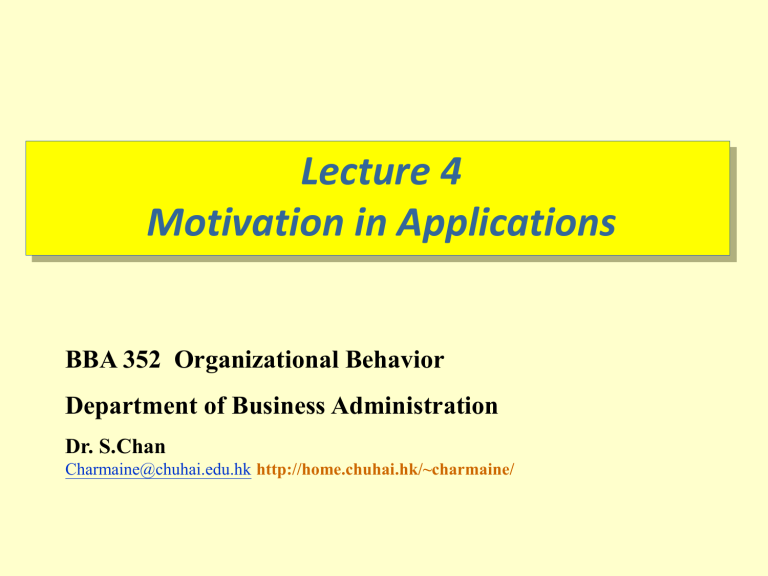
Lecture 4
Motivation in Applications
BBA 352 Organizational Behavior
Department of Business Administration
Dr. S.Chan
Charmaine@chuhai.edu.hk
http://home.chuhai.hk/~charmaine/
Motivation by Job Design: The JCM
Job Characteristics Model (JCM)
– Hackman and Oldham’s concept that any job can be described through five core job dimensions:
• Skill variety – Requirements for different tasks in the job.
•
Task identity
– Completion of a whole piece of work.
•
Task significance
– The job’s impact on others.
•
Autonomy
– Level of discretion in decision making.
•
Feedback
– Amount of direct and clear information on performance.
– The way elements in a job are organized ( job design ) impacts motivation, satisfaction, and performance.
6-1
How Can Jobs Be Redesigned?
Job Rotation
–
The periodic shifting of a worker from one task to another
Job Enlargement
–
The horizontal expansion of jobs
Job Enrichment
–
The vertical expansion of jobs
6-2
Guidelines for Enriching a Job
Source: J.R. Hackman and J.L. Suttle, eds., Improving Life at Work (Glenview, IL: Scott Foresman, 1977), p. 138.
6-3
Alternative Work Arrangements
Flextime
–
Employees work during a common core time period each day but have discretion in forming their total workday from a flexible set of hours outside the core.
Job Sharing
–
The practice of having two or more people split a 40-hour-aweek job
6-4
Another Alternative: Telecommuting
Telecommuting
–
Employees do their work at home at least two days a week on a computer that is linked to their office.
The Virtual Office
–
Employees work out of their home on a relatively permanent basis.
Typical Telecommuting Jobs
–
Professional and other knowledge-related tasks
– Routine information-handling tasks
–
Mobile activities
Reasons for and against Telecommuting
Advantages
–
Larger labor pool
–
Higher productivity
–
Less turnover
–
Improved morale
– Reduced office-space costs
Disadvantages
Employer
– Less direct supervision of employees
–
Difficult to coordinate teamwork
–
Difficult to evaluate nonquantitative performance
Employee
– May not be as noticed for his or her efforts
Motivation Is Not the Whole Story
Ability
(A)
Motivation
(M)
Opportunity to Perform
(O)
Performance
(P)
P = f(A x M x O)
© 2009 Prentice-Hall Inc. All rights reserved.
Employee Involvement
A participative process that uses the input of employees to increase their commitment to the organization’s success.
By increasing worker autonomy and control over work lives (involvement), organizations:
–
Increase employee motivation
– Gain greater organizational commitment
–
Experience greater worker productivity
–
Observe higher levels of job satisfaction
6-8
Types of Employee Involvement Programs
Participative Management
–
Subordinates share a significant degree of decision-making power with their immediate superiors
Representative Participation
– Works councils
• Groups of nominated or elected employees who must be consulted for any personnel decisions
–
Board representative
• An employee sits on a company’s board of directors and represents the interests of the firm’s employees
Quality Circle
–
A work group of employees who meet regularly to discuss their quality problems, investigate causes, recommend solutions, and take corrective actions
Motivational Theory Links to EI Programs
Theory Y
• Employees want to be involved
• Managerial viewpoint
Two-Factor
Theory
• Intrinsic
Motivation
• Growth
• Responsibility
• Involvement
ERG Theory
• Stimulate nAch
• Growth
• Recognition
• Self-esteem
Four Major Strategic Reward Decisions
1. What to pay? (pay structure)
2. How to pay individuals?
(variable pay plans and skillbased pay plans)
3. What benefits to offer? Do we offer choice of benefits?
(flexible benefits)
4. How to build recognition programs?
6-11
1. What to Pay – Pay Structure
Internal equity
–
The worth of the job to the organization
– Determined by job evaluations
External equity
– The competitiveness of the company’s pay relative to pay elsewhere in the industry
–
Determined through pay surveys
Choose organizational position
– Pay leaders
• Greater employee loyalty
• Attracts better-quality employees
–
Pay laggards – accept high turnover for low hourly costs
6-12
2. How to Pay - Variable Pay Programs
Types of Variable Pay Programs
A portion of an employee’s pay is based on some individual and/or organizational measure of performance
–
Piece Rate:
• Workers are paid a fixed sum for each unit of production completed
• Weakness: not feasible for many jobs
–
Merit-Based:
• Based on performance appraisal ratings
• Gap increasing between average and top-performers
• Weaknesses: validity of system based on annual appraisals, pay pool can be small, unions strongly resist
–
Bonuses:
• Rewards recent performance
• Weakness: employees consider this a pay
6-13
2. How to Pay - Skill-Based Pay Programs
Types of Skill-Based Programs:
Also known as competency- or knowledge-based pay - sets pay based on skills or number of jobs an employee can perform. To some extent, variable pay does increase motivation and productivity
Benefits of Skill-based Pay Plans
– Provide staffing flexibility
– Facilitate communication across the organization
– Lessen “protection of territory” behaviors
– Meet the needs of employees for advancement
–
Lead to performance improvements
Drawbacks:
–
Lack of additional learning opportunities
– Continuing to pay employees for obsolete skills
– Paying for skills of no immediate use to the organization
– Paying for a skill, not for performance of the skill
3. How to Build Recognition Programs
Intrinsic Rewards: Stimulate Intrinsic Motivation
–
Personal attention given to employee
– Approval and appreciation for a job well done
–
Growing in popularity and usage
Benefits of Programs
– Fulfill employees’ desire for recognition
–
Inexpensive to implement
–
Encourage repetition of desired behaviors
Drawbacks of Programs
– Susceptible to manipulation by management
Summary and Managerial Implications
To Motivate Employees
–
Recognize individual differences
–
Use goals and feedback
–
Allow employees to participate in decisions that affect them
–
Link rewards to performance
– Check the reward system for equity
6-16
